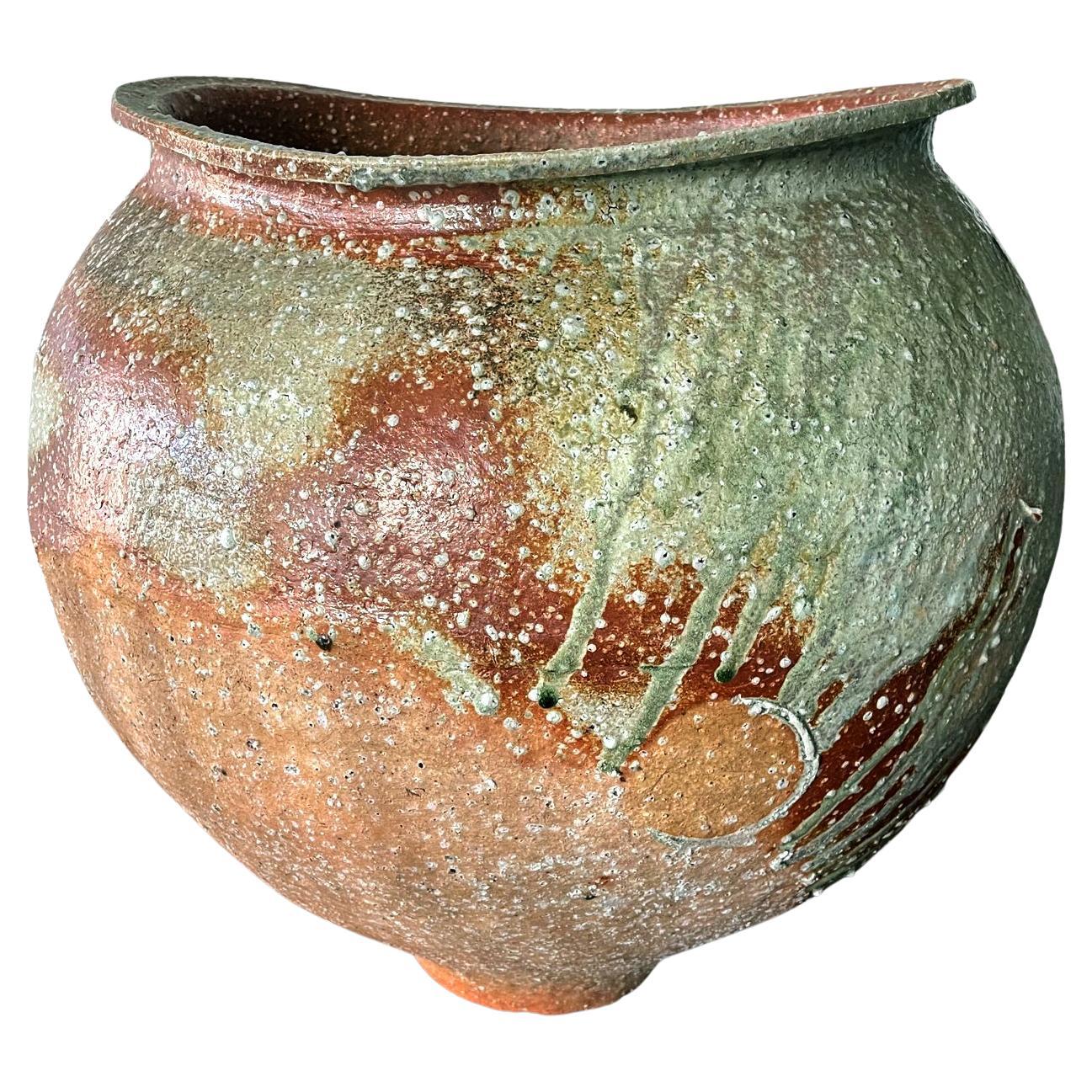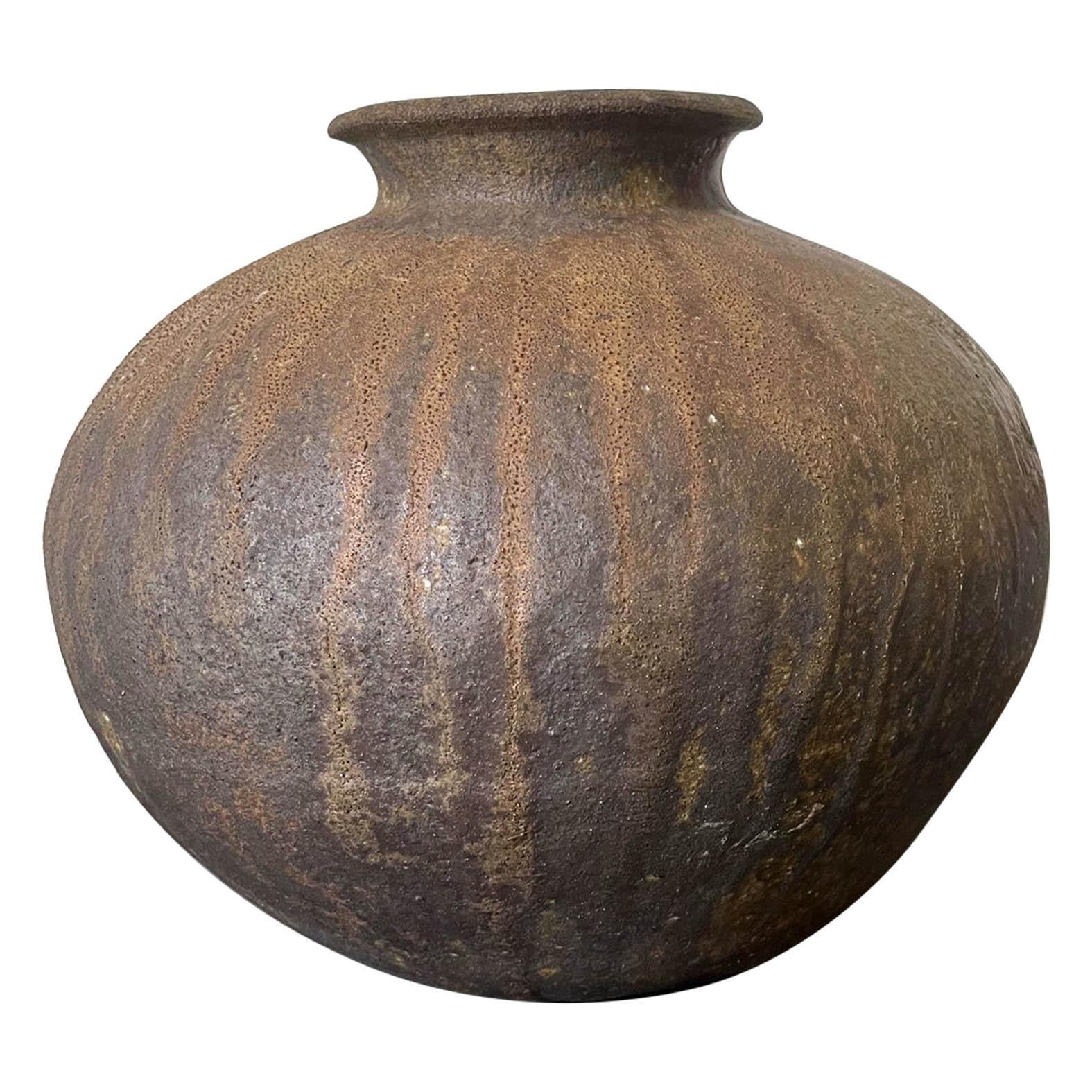Items Similar to Massive Ceramic Jar Tsubo by Japanese Potter Tsujimura Yui
Want more images or videos?
Request additional images or videos from the seller
1 of 21
Massive Ceramic Jar Tsubo by Japanese Potter Tsujimura Yui
About the Item
A massive and magnificent ceramic Tsubo jar by Japanese potter Tsujimura Yui (1975-). Inspired by the techniques and aesthetics of the early medieval Sue ware, the artist hand builds an impressive voluminous oviform, irregular by intention, from a combination clay from both Shigaraki and Iga, coarse by nature and rich in feldspar. Fired on their sides horizontally, the surface of the thick wall tsubo is covered with streaks and drips of natural ash glazes in shades of green and blue, forming an abstract and mesmerizing pattern that resembles geothermal earth activity. Additional ashes are blown during the firing to accentuate the textures. Most recognizably, there are many circular marks scattered on the surface of his archaic looking vessels. That is resulted from using stacked tea bowls to prevent the conjoining of the vessels. After the firing, the stacked vessels are chipped away, leaving behind those circular impression, as well as deep pools of glaze which gather where they were placed.
Born in 1975, Tsujimura Yui is the first son of the contemporary ceramic artist Tsujimura Shiro (b. 1947). His work is based firmly on archaic tradition but captures the viewers with a new contemporary energy.
The jar comes with a fitted wood storage box (tomobako), signed and sealed Yui and inscribed Shizen yu O-tsubo (Large jar with natural ash glaze).
For a similar storage jar in the collection of the Metropolitan Museum of Art (The MET), accession number 2010.563.
- Creator:Tsujimura Yui (Artist)
- Dimensions:Height: 24.5 in (62.23 cm)Diameter: 23.5 in (59.69 cm)
- Style:Modern (Of the Period)
- Materials and Techniques:Ceramic,Glazed
- Place of Origin:
- Period:
- Date of Manufacture:2000s
- Condition:Wear consistent with age and use. Jar in fine condition with intended surface. The lid of the storage wood box has a crack line that was reglued.
- Seller Location:Atlanta, GA
- Reference Number:1stDibs: LU945030062882
About the Seller
5.0
Platinum Seller
These expertly vetted sellers are 1stDibs' most experienced sellers and are rated highest by our customers.
Established in 2006
1stDibs seller since 2010
479 sales on 1stDibs
Typical response time: <1 hour
- ShippingRetrieving quote...Ships From: Atlanta, GA
- Return PolicyA return for this item may be initiated within 2 days of delivery.
More From This SellerView All
- Large Contemporary Ceramic Tsubo Jar by Kai TsujimuraLocated in Atlanta, GAA massive stoneware tsubo floor jar created by Japanese contemporary ceramic artist Kai Tsujimura (1976-). The heavy jar with its impressive volume was made in the tradition of Iga ware with local coarse sandy clay that turned reddish after the firing. It took its shape from heavy medieval storage jars with a wide-open mouth. For a nearly identical form, see an Echizen jar from Heian period (794–1185) in the collection of MET (Accession Number: 1977.261). The surface showcases scattered white crystalized feldspars and a green vitrified ash glaze cascade down the body (known as biidoro in Japanese - after the Portuguese word for glass vidoro). These is a globular shape impressed on the jar. It is a signature practice of the Tsujimura potter family by stacking bowls between the pieces in the kiln during the firing, resulting in an accidental but iconic aethetic (Kai and Yui Tsujimura...Category
2010s Japanese Organic Modern Ceramics
MaterialsStoneware
- Large Japanese Antique Shigaraki Tsubo JarLocated in Atlanta, GAAn antique Japanese stoneware storage jar, known as tsubo from Shigaraki kiln, circa 17th-18th century (early Edo possibly Momoyama period)....Category
Antique 17th Century Japanese Japonisme Ceramics
MaterialsCeramic
- Japanese Echizen Ceramic Tsubo Fujita Jurouemon VIIILocated in Atlanta, GAA Japanese storage jar (tsubo) made in the ancient Echizen ware tradition by Fujita Jurouemon VIII. Echizen is one of the six ancient kilns in Japan, directly influenced by the Sue ware...Category
20th Century Japanese Modern Ceramics
MaterialsCeramic
- Japanese Modern Studio Ceramic Oribe Jar by Ryoji KoieBy Ryoji KoieLocated in Atlanta, GAA glazed ceramic vessel by Japanese potter Ryoji Koie (1938-2020). Hand-built with intention to be seen as such, the tsubo has a primordial irregular form with a small opening and a swelled body resembling a beehive. The upper body was covered in a glassy green oribe glaze with fine crackles, highlighted with three incised geometrical symbols. The lower body is unglazed and exposed the white clay with marks of the hand-making pinches and kneading along the base. The base also shows highly irregular surface due to the seashell spur marks and clay pitting in the kiln during the firing process. All these occurrences honestly preserved and presented as part of the character of this wonderful modern piece. The jar comes with a plain wooden tomobako box. "One of Japan’s most versatile and forward-thinking contemporary artists, KOIE RYOJI...Category
21st Century and Contemporary Japanese Modern Ceramics
MaterialsCeramic
- Fine Japanese Satsuma Ceramic Jar with Gilt Decoration by KinkozanBy KinkozanLocated in Atlanta, GAA large Japanese ceramic vase from end of Meiji period circa 1880s- 1910s by Kinkozan (1645-1927). One of the largest studio manufacturers of the export ceramics at the time based in Kyoto. In the typical style of satsuma made at the turn of 20th century, the vase is of a moon jar shape and finely decorated with kinran-de (gold paint) on a cream white background with even fine crackles. What sets this particular vase apart from many lower quality and mass-produced pieces is the meticulously renditioned surface decoration. Lavishly gilded with a continuous design, the carefully composed imagery depicts an elaborately decorated float cart in a festival parade. A group of people are seated within the float with a woman and a child standing in the front. Surrounding the float are streams of marchers dressed...Category
Early 20th Century Japanese Meiji Ceramics
MaterialsCeramic
- Large Japanese Contemporary Ceramic Jar from Onda Yaki KilnBy Onda YakiLocated in Atlanta, GAA large Japanese lidded ceramic jar from the kiln of Onda Yaki, circa 2010. The stoneware jar impresses the viewer with a robust bulbous form. Its black body is nearly unglazed but exuberantly splashed with strokes of slip glazes of white, yellow and blue. The visual effect is wonderful that it appears traditional and contemporary at the same time. The tri-color glaze calls to mind the San-Cai from Chinese Tang dynasty, yet the application is akin to abstract painting on canvas. Onda Yaki also spelled as Onta Yaki also spelled Onta, is a type of Japanese pottery produced in and around the village of Onta in Oita Prefecture in Kyushu Island. It was founded in 1705. Closely associated with Mingei folk art, Onda ware was inscribed by the national government in 1995 as an Intangible Cultural Property Background from Pucker Gallery where the jar was exibited and purchased. "In his search for true folk pottery, the Japanese philosopher Soetsu Yanagi...Category
2010s Japanese Organic Modern Ceramics
MaterialsCeramic
You May Also Like
- Japanese Antique Momoyama Edo Bizen Ware Pottery Wabi-Sabi Art Tsubo Jar VaseLocated in Studio City, CAAn absolutely stunning Bizen ware stoneware vase/jar/vessel - produced sometime during the late Momoyama period (1568-1600) / Early Edo Period (1603-1867). Bizen yaki...Category
Antique 16th Century Japanese Edo Ceramics
MaterialsStoneware
- Japanese Antique Muromachi Edo Wabi-Sabi Tokoname Art Pottery Jar Tsubo Pot VaseLocated in Studio City, CAAn absolutely stunning Tokoname ware stoneware vase/jar/vessel - produced sometime during the late Muromachi period (1336-1573 to early Edo Period (1603-1867). Tokoname-yaki ware is ...Category
Antique 16th Century Japanese Edo Ceramics
MaterialsPottery, Stoneware
- Japanese Antique Edo Wabi-Sabi Tamba Tanba Large Art Pottery Jar Tsubo Pot VaseLocated in Studio City, CAAn absolutely stunning Tamba (Tanba) ware Japanese pottery vase/jar/pot - produced sometime during the Edo Period (1603-1867). Tamba-yaki ware is a type of Japanese pottery and ceram...Category
Antique 18th Century Japanese Edo Ceramics
MaterialsPottery
- Japanese Antique Edo Wabi-Sabi Bizen Ware Large Art Pottery Jar Tsubo Pot VaseLocated in Studio City, CAAn absolutely stunning Bizen ware stoneware vase/tsubo jar/vessel - produced sometime during the mid to late Edo period (1603-1867). Bizen yaki ware is a ty...Category
Antique Mid-19th Century Japanese Edo Ceramics
MaterialsPottery, Stoneware
- Japanese Glazed Tsubo Wine Jar, c. 1875Located in Chicago, ILThis large, glazed stoneware vessel is a Meiji-era Japanese storage jar (tsubo) used for storing rice wine, water or even tea leaves and spices. Sometimes referred to as a Martaban j...Category
Antique Late 19th Century Japanese Meiji Ceramics
MaterialsStoneware
- Large Japanese Meiji Kyo-Ware Porcelain 'Tsubo' Vase by Kanzan Denshichi 幹山伝七By Kanzan Denshichi 幹山伝七Located in Amsterdam, NLTall and exceptionally made Kyo-ware porcelain jar (tsubo) with a naturalistically relief design of a coral-coloured net stretched around the body. On the shoulder hangs a beautifully draped red...Category
Antique Late 19th Century Japanese Ceramics
MaterialsPorcelain
Recently Viewed
View AllMore Ways To Browse
Ceramic Japan
Ceramic Jar
Japanese Inspired Furniture
Japanese Glazed Ceramic
Early Medieval
Japanese Modern Ceramics
Modern Japan Ceramic
Contemporary Asian Wall Art
Japan Jar
Thick Massive
Japanese Ceramic Collections
Japanese Clay Artist
Japanese Signed Ceramic
Archaic Modern
Japanese Side Box
Horizontal Japanese
Japanese Green Ceramics
Large Ceramic Jar





